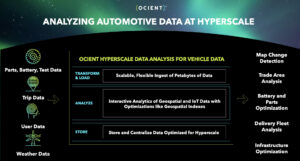 By Dylan Murphy, VP of Product Management at Ocient
By Dylan Murphy, VP of Product Management at Ocient
If you follow the future of vehicle telematics and in particular the industry-wide push towards automated, electronically powered cars and trucks, you have most likely noticed the new, and some might say surprising partnerships between competitors such as Tesla, General Motors and Ford.
As CNBC reports: “Ford announced it had made a deal with Tesla that will allow Ford EVs to use Tesla’s charging stations with an adapter — and that starting in 2025, it will make Tesla’s charging tech standard on its own EVs. It was a surprising partnership between rivals, and on Thursday, General Motors said it struck a nearly identical deal with Tesla.”
But if you’re familiar with the growing data sets and competitive trends in the field, the challenges that encourage consolidation of new charging infrastructure are clear. By 2025, there will be 116 million connected cars in the United States. A closer look at the historical data that measures the optimization and utilization of charging stations for these connected cars is an area that we’ve been following closely. In fact, the demo below shows how a hyperscale data warehouse like Ocient has the potential to unlock new real-time insights and capabilities in this emerging field.
As you can see in the demo, as the number of electric vehicles on the road continues to grow, it is crucial to ensure that there are enough charging stations to meet the increasing demand and automakers need to act with precision to use resources efficiently. Understanding and visualizing the utilization patterns of these charging stations is vital for optimizing their placement and ensuring effective usage. I show how leveraging the power of geospatial analytics married with in-database machine learning can predict gaps at locations that may need more charging stations, what some have called “charging deserts” or in some areas may be underutilized. Using a dataset specific to the Chicago area, we focus on answering the following questions:
- What are the most and least frequently visited charging stations?
- Which charging locations have the least number of unique vehicles visiting?
- Which charging stations are furthest from another charging station?
It’s the Ocient Hyperscale Data Warehouse’s advanced data analysis capabilities offer unique answers to these questions. By leveraging geospatial analytics and in-database machine learning on complex datasets, Ocient can provide valuable insights for decision makers building and maintaining these charging stations. The ability to predict gaps in charging station coverage is invaluable for urban planners, policymakers, and businesses looking to invest in charging infrastructure. This empowers stakeholders to make informed choices about where to deploy new charging stations, ensuring that they are located in areas where they will have the greatest impact.
Beyond facilitating the growth of electric vehicles, Ocient’s solution also contributes to broader environmental and societal goals. By encouraging the adoption of electric vehicles through optimized charging infrastructure, we can significantly reduce greenhouse gas emissions and promote cleaner air in our cities. Additionally, by reducing congestion and enabling more efficient charging experiences, we enhance the overall convenience and satisfaction of electric vehicle owners.
Below is a closer look at our approach of analyzing automotive data at hyperscale with Ocient.

In conclusion, it’s important work that we believe can create safer roads, lower emissions, and less congestion across roadways while also allowing automakers of the future to grow efficiently and enabling a best-in-class customer experience.
If you are interested in seeing the capabilities of our platform firsthand, we invite you to get in touch for a live demo.

